Analysis of CO2 Concentration and Fluxes of Lisbon Portugal Using Regional CO2 Assimilation Method Based on WRF-Chem
Abstract
1. Introduction
2. Materials and Methods
2.1. ODIAC Emission Dataset
2.2. OCO-2 XCO2 Retrieval Dataset
2.3. CO2 Assimilation System
2.4. Research Area
2.5. Experiment Conditions and Materials
3. Results and Discussion
3.1. Assimilation Experiment Results
3.2. Comparison with TCCON
3.3. Comparison with ObsPack
4. Conclusions
Author Contributions
Funding
Institutional Review Board Statement
Informed Consent Statement
Data Availability Statement
Acknowledgments
Conflicts of Interest
References
- The State of Greenhouse Gases in the Atmosphere Based on Global Observations through 2020. WMO Greenh. Gas Bull. 2021, 17. Available online: https://reliefweb.int/report/world/wmo-greenhouse-gas-bulletin-state-greenhouse-gases-atmosphere-based-global-2 (accessed on 29 May 2025).
- Masson-Delmotte, V.; Zhai, P.; Pirani, A.; Connors, S.L.; Péan, C.; Berger, S.; Caud, N.; Chen, Y.; Goldfarb, L.; Gomis, M.I.; et al. (Eds.) The Physical Science Basis. Contribution of Working Group I to the Sixth Assessment Report of the Intergovernmental Panel on Climate Change. In IPCC(2021): Climate Change 2021; Cambridge University Press: Cambridge, UK; New York, NY, USA, 2021. [Google Scholar]
- Agency, I.E. World Energy Outlook 2008. SourceOECD Energy 2008, 2008, 578. [Google Scholar]
- Marcotullio, P.J.; Sarzynski, A.; Albrecht, J.; Schulz, N. A Top-Down Regional Assessment of Urban Greenhouse Gas Emissions in Europe. Ambio 2014, 43, 957–968. [Google Scholar] [CrossRef][Green Version]
- Sonwani, S.; Saxena, P. Introduction to greenhouse gases: Sources, sinks and mitigation. In Greenhouse Gases: Sources, Sinks and Mitigation; Springer: Berlin/Heidelberg, Germany, 2022; pp. 1–7. [Google Scholar] [CrossRef]
- ICOS RI. ICOS Atmosphere Station Specifications V2.0; Laurent, O., Ed.; ICOS ERIC: Helsinki, Finland, 2020. [Google Scholar]
- Wennberg, P.O.; Wunch, D.; Roehl, C.M.; Blavier, J.-F.; Toon, G.C.; Allen, N.T. TCCON Data from Caltech (US). Release GGG2014.R1. 2015. Available online: https://data.caltech.edu/records/285 (accessed on 29 May 2025).
- Crippa, M.; Janssens-Maenhout, G.; Guizzardi, D.; Muntean, M.; Schaaf, E. Emissions Database for Global Atmospheric Research, Version v7.0 Part II Air Pollutants (Gridmaps); European Commission: Brussels, Belgium; Joint Research Centre (JRC): Ispra, Italy, 2018; Available online: https://edgar.jrc.ec.europa.eu/emissions_data_and_maps (accessed on 29 May 2025).
- Huijnen, V.; Williams, J.; van Weele, M.; van Noije, T.; Krol, M.; Dentener, F.; Segers, A.; Houweling, S.; Peters, W.; de Laat, J.; et al. The global chemistry transport model TM5: Description and evaluation of the tropospheric chemistry version 3.0. Geosci. Mod. Develop. 2010, 3, 445–473. [Google Scholar] [CrossRef]
- Skamarock, W.C.; Klemp, J.B. A time-split nonhydrostatic atmospheric model for weather research and forecasting applications. J. Comput. Phys. 2008, 227, 3465–3485. [Google Scholar] [CrossRef]
- Skamarock, W.C.; Klemp, J.; Dudhia, J.; Gill, D.; Barker, M.; Duda, K.; Wang, W.; Powers, J.G. A Description of the Advanced Research WRF Version 3; NCAR Tech. Note TN-475_STR; University Corporation for Atmospheric Research: Boulder, CO, USA, 2008. [Google Scholar]
- Grell, G.A.; Peckham, S.E.; Schmitz, R.; McKeen, S.A.; Frost, G.; Skamarock, W.C.; Eder, B. Fully coupled “online” chemistry within the WRF model. Atmos. Envir. 2005, 39, 6957–6975. [Google Scholar] [CrossRef]
- Fast, J.D.; Gustafson, W.I., Jr.; Easter, R.C.; Zaveri, R.A.; Barnard, J.C.; Chapman, E.G.; Grell, G.A.; Peckham, S.E. Evolution of ozone, particulates, and aerosol direct radiative forcing in the vicinity of Houston using a fully coupled meteorology-chemistry-aerosol model. J. Geophys. Res. Atmos. 2006, 111. [Google Scholar] [CrossRef]
- Peters, W.; Jacobson, A.R.; Sweeney, C.; Andrews, A.E.; Conway, T.J.; Masarie, K.; Miller, J.B.; Bruhwiler, L.M.P.; Pétron, G.; Hirsch, A.I.; et al. An atmospheric perspective on north american carbon dioxide exchange: CarbonTracker. Proc. Natl. Acad. Sci. USA 2007, 104, 18925–18930. [Google Scholar] [CrossRef]
- Lauvaux, T.; Uliasz, M.; Sarrat, C.; Chevallier, F.; Bousquet, P.; Lac, C.; Davis, K.J.; Ciais, P.; Denning, A.S.; Rayner, P.J. Mesoscale inversion: First re-sults from the CERES campaign with synthetic data. Atmos. Chem. Phys. 2008, 8, 3459–3471. [Google Scholar] [CrossRef]
- Lauvaux, T.; Davis, K.; Miles, N.; Richardson, S.; Stauffer, D. A WRF-Chem realtime modeling system for monitoring CO2 emissions. Extended Abstracts. In Proceedings of the 13th An-nual WRF Users’ Workshop, Boulder, CO, USA, 25–29 June 2012; p. 33. [Google Scholar]
- Lauvaux, T.; Gioli, B.; Sarrat, C.; Rayner, P.J.; Ciais, P.; Chevallier, F.; Noilhan, J.; Miglietta, F.; Brunet, Y.; Ceschia, E.; et al. Bridging the gap between atmospheric concentrations and local ecosystem measurements. Geophys. Res. Lett. 2009, 36. [Google Scholar] [CrossRef]
- Schuh, A.E.; Denning, A.S.; Corbin, K.D.; Baker, I.T.; Uliasz, M.; Parazoo, N.; Andrews, A.E.; Worthy, D.E.J. A re-gional high-resolution carbon flux inversion of North America for 2004. Biogeosciences 2010, 7, 1625–1644. [Google Scholar] [CrossRef]
- Schuh, A.E.; Lauvaux, T.; West, T.O. Evaluating atmospheric CO2 inversions at multiple scales over a highly inventoried agricultural landscape. Glo. Chan. Bio. 2013, 19, 1424–1439. [Google Scholar] [CrossRef]
- Wu, L.; Broquet, G.; Ciais, P.; Bellassen, V.; Vogel, F.; Chevallier, F.; Xueref-Remy, I.; Wang, Y. What would dense atmospheric observation networks bring to the quantification of city CO2 emissions? Atmos. Chem. Phys. 2016, 16, 7743–7771. [Google Scholar] [CrossRef]
- Lauvaux, T.; Miles, N.L.; Richardson, S.J.; Deng, A.; Stauffer, D.R.; Davis, K.J.; Jacobson, G.; Rella, C.; Calonder, G.-P.; DeCola, P.L. Urban Emissions of CO2 from Davos, Switzerland: The First Real-Time Monitoring System Using an Atmospheric Inversion Technique. J. Appl. Meteo. Climat. 2013, 52, 2654–2668. [Google Scholar] [CrossRef]
- Lowry, D.; Holmes, C.W.; Rata, N.D.; O’Brien, P.; Nisbet, E.G. London methane emissions: Use of diurnal changes in concentration and d13Cto identify urban sources and verify inventories. J. Geophys. Res. 2001, 106, 7427–7448. [Google Scholar] [CrossRef]
- Strong, C.; Stwertka, C.; Bowling, D.R.; Stephens, B.B.; Ehleringer, J.R. Urban carbon dioxide cycles within the Salt Lake Valley: A multiple-box model validated by bservations. J. Geophys. Res. 2011, 116, D15307. [Google Scholar] [CrossRef]
- Masson, V.; Grimmond, C.; Oke, T. Evaluation of the town energy balance (TEB) scheme with direct measurements from dry districts in two cities. J. Appl. Meteor. 2002, 41, 1011–1026. [Google Scholar]
- Hanna, S.R.; Paine, R.; Heinold, D.; Kintigh, E.; Baker, D. Uncertainties in air toxics calculated by the dispersion models AERMOD and ISCST3 in the Houston ship channel area. J. Appl. Meteor. Climatol. 2007, 46, 1372–1382. [Google Scholar] [CrossRef]
- Lac, C.; Donnelly, R.P.; Masson, V.; Pal, S.; Riette, S.; Donier, S.; Queguiner, S.; Tanguy, G.; Ammoura, L.; Xueref-Remy, I. CO2 dispersion modelling over paris region within the CO2-MEGAPARIS project. Atmos. Chem. Phys. Discuss. 2012, 12, 28155–28193. [Google Scholar] [CrossRef]
- Friedlingstein, P.; Jones, M.W.; O’Sullivan, M.; Andrew, R.M.; Bakker, D.C.E.; Hauck, J.; Quéré, C.L.; Peters, G.P.; Peters, W.; Pongratz, J.; et al. Global Carbon Budget 2021. Earth Syst. Sci. Data Discuss. 2022, 14, 1917–2005. [Google Scholar] [CrossRef]
- Weir, B.; Crisp, D.; O’Dell, C.W.; Basu, S.; Chatterjee, A.; Kolassa, J.; Oda, T.; Pawson, S.; Poulter, B.; Zhang, Z.; et al. Regional impacts of COVID-19 on carbon dioxide detected worldwide from space. Sci. Adv. 2021, 7, eabf9415. [Google Scholar] [CrossRef] [PubMed]
- Mizzi, A.P.; Edwards, D.P.; Anderson, J.L. Assimilating compact phase space retrievals (CPSRs): Comparison with independent observations (MOZAIC in situ and IASI retrievals) and extension to assimilation of truncated retrieval profiles. Geosci. Mod. Develop. 2018, 11, 3727–3745. [Google Scholar] [CrossRef]
- Mizzi, A.P.; Arellano, A.F., Jr.; Edwards, D.P.; Anderson, J.L.; Pfister, G.G. Assimilating compact phase space retrievals of atmospheric composition with WRF-Chem/DART: A regional chemical transport/ensemble Kalman filter data assimilation system. Geosci. Mod. Develop. 2016, 9, 965–978. [Google Scholar] [CrossRef]
- Zhang, Q.; Li, M.; Wei, C.; Mizz, A.P.; Huang, Y.; Gu, Q. Assimilation of OCO-2 retrievals with WRF-Chem/DART: A case study for the Midwestern United States. Atmos. Envir. 2021, 246, 118106. [Google Scholar] [CrossRef]
- Anderson, J.; Hoar, T.; Raeder, K.; Liu, H.; Collins, N.; Torn, R.; Avellano, A. The Data Assimilation Research Testbed A Community Facility. Bull. Ameri. Meteor. Soci. 2009, 90, 1283–1296. [Google Scholar] [CrossRef]
- Oda, T.; Maksyutov, S. A very high-resolution (1 km × 1 km) global fossil fuel CO2 emission inventory derived using a point source database and satellite observations of nighttime lights. Atmos. Chem. Phys. 2011, 11, 543–556. [Google Scholar] [CrossRef]
- Crowell, S.; Baker, D.; Schuh, A.; Basu, S.; Jacobson, A.R.; Chevallier, F.; Liu, J.; Deng, F.; Feng, L.; McKain, K.; et al. The 2015–2016 carbon cycle as seen from OCO-2 and the global in situ network. Atmos. Chem. Phys. 2019, 9, 9797–9831. [Google Scholar] [CrossRef]
- Osterman, G.; Eldering, A.; Avis, C.; Chafin, B.; O’Dell, C.; Frankenberg, C.; Fisher, B.; Mandrake, L.; Wunch, D.; Granat, R.; et al. Orbiting carbon observatory–2 (OCO-2) data product user’s guide, operational L1 and L2 data versions 8 and lite file version 9, version 1. ReVision J. 2018. Available online: https://disc.gsfc.nasa.gov/datasets?page=1 (accessed on 29 May 2025).
- Wunch, D.; Wennberg, P.O.; Osterman, G.; Fisher, B.; Naylor, B.; Roehl, C.M.; O’Dell, C.; Mandrake, L.; Viatte, C.; Kiel, M.; et al. Comparisons of the orbiting carbon observatory-2 (OCO-2) XCO2 measurements with TCCON. Atmos. Measure. Tech. 2017, 10, 2209–2238. [Google Scholar] [CrossRef]
- Connor, B.J.; Boesch, H.; Toon, G.; Sen, B.; Miller, C.; Crisp, D. Orbiting Carbon Observatory: Inverse method and prospective error analysis. J. Geophys. Res. Atmos. 2008, 113. [Google Scholar] [CrossRef]
- Jacobson, A.R.; Schuldt, K.N.; Tans, P.; Andrews, A.; Miller, J.B.; Oda, T.; Basu, S.; Mund, J.; Weir, B.; Ott, L.; et al. CarbonTracker CT20222. Model Published by NOAA Global Monitoring Laboratory. 2023. Available online: https://gml.noaa.gov/ccgg/carbontracker/CT2022/ (accessed on 29 May 2025).
- Giordano, C.; Vernin, J.; Trinquet, H.; Muñoz-Tuñón, C. Weather Research and Forecasting prevision model as a tool to search for the best sites for astronomy: Application to La Palma, Canary Islands. Month. Noti. Royal Astro. Soci. 2014, 440, 1964–1970. [Google Scholar] [CrossRef]
- Shikhovtsev, A.Y.; Kovadlo, P.G.; Lezhenin, A.A.; Gradov, V.S.; Zaiko, P.O.; Khitrykau, M.A.; Kirichenko, K.E.; Driga, M.B.; Kiselev, A.V.; Russkikh, I.V.; et al. Simulating Atmospheric Characteristics and Daytime Astronomical Seeing Using Weather Research and Forecasting Model. Appl. Sci. 2023, 13, 6354. [Google Scholar] [CrossRef]
- Huang, Y.; Wei, J.; Jin, J.; Zhou, Z.; Gu, Q. CO Fluxes in Western Europe during 2017–2020 Winter Seasons Inverted by WRF-Chem/Data Assimilation Research Testbed with MOPITT Observations. Remot. Sens. 2022, 14, 1133. [Google Scholar] [CrossRef]
- Zhang, Q.; Li, M.; Wang, M.; Mizzi, A.P.; Huang, Y.; Wei, C.; Jin, J.; Gu, Q. CO2 Flux over the Contiguous United States in 2016 Inverted by WRF-Chem/DART from OCO-2 XCO2 Retrievals. Remot. Sens. 2021, 13, 2996. [Google Scholar] [CrossRef]
- Schneising, O.; Reuter, M.; Buchwitz, M.; Heymann, J.; Bovensmann, H.; Burrows, J.P. Terrestrial carbon sink observed from space: Variation of growth rates and seasonal cycle amplitudes in response to interannual surface temperature variability. Atmos. Chem. Phys. 2014, 14, 133–141. [Google Scholar] [CrossRef]
- Michael, B.; Maximilian, R.; Noël, S.; Bramstedt, K.; Schneising, O.; Hilker, M.; Andrade, B.F.; Bovensmann, H.; Burrows, J.P.; Noia, A.D.; et al. Can a regional-scale reduction of atmospheric CO2 during the COVID-19 pandemic be detected from space? A case study for East China using satellite XCO2 retrievals. Atmos. Meas. Tech. 2021, 14, 2141–2166. [Google Scholar]
- Hong, S.Y.; Dudhia, J.; Chen, S.H. A Revised Approach to Ice Microphysical Processes for the Bulk Parameterization of Clouds and Precipitation. Month. Weath. Rev. 2004, 132, 103–120. [Google Scholar] [CrossRef]
- Kain, J.S.; Kain, J. The Kain - Fritsch convective parameterization: An update. J. Applied Meteor. 2004, 43, 170–181. [Google Scholar] [CrossRef]
- Mlawer, E.J.; Taubman, S.J.; Brown, P.D.; Iacono, M.J.; Clough, S.A. Radiative transfer for inhomogeneous atmospheres: RRTM, a validated correlated-k model for the longwave. J. Geophys. Res. Bio. 1997, 102, 16663–16682. [Google Scholar] [CrossRef]
- Dudhia, J. Numerical Study of Convection Observed during the Winter Monsoon Experiment Using a Mesoscale Two-Dimensional Model. J. Atmos. Sci. 1989, 46, 3077–3107. [Google Scholar] [CrossRef]
- Anderson, J.L. An ensemble adjustment Kalman filter for data assimilation. Month. Weath. Rev. 2001, 129, 2884–2903. [Google Scholar] [CrossRef]
- Schuldt, K.N.; Mund, J.; Aalto, T.; Abshire, J.B.; Aikin, K.; Allen, G.; Andrade, M.; Andrews, A.; Apadula, F.; Arnold, S.; et al. Multi-Laboratory Compilation of Atmospheric Carbon Dioxide DATA for the period 1957–2023. obspack_co2_1_GLOBALVIEWplus_v10.1_2024-11-13. 2024. Available online: https://gml.noaa.gov/ccgg/obspack/citation.php (accessed on 29 May 2025).
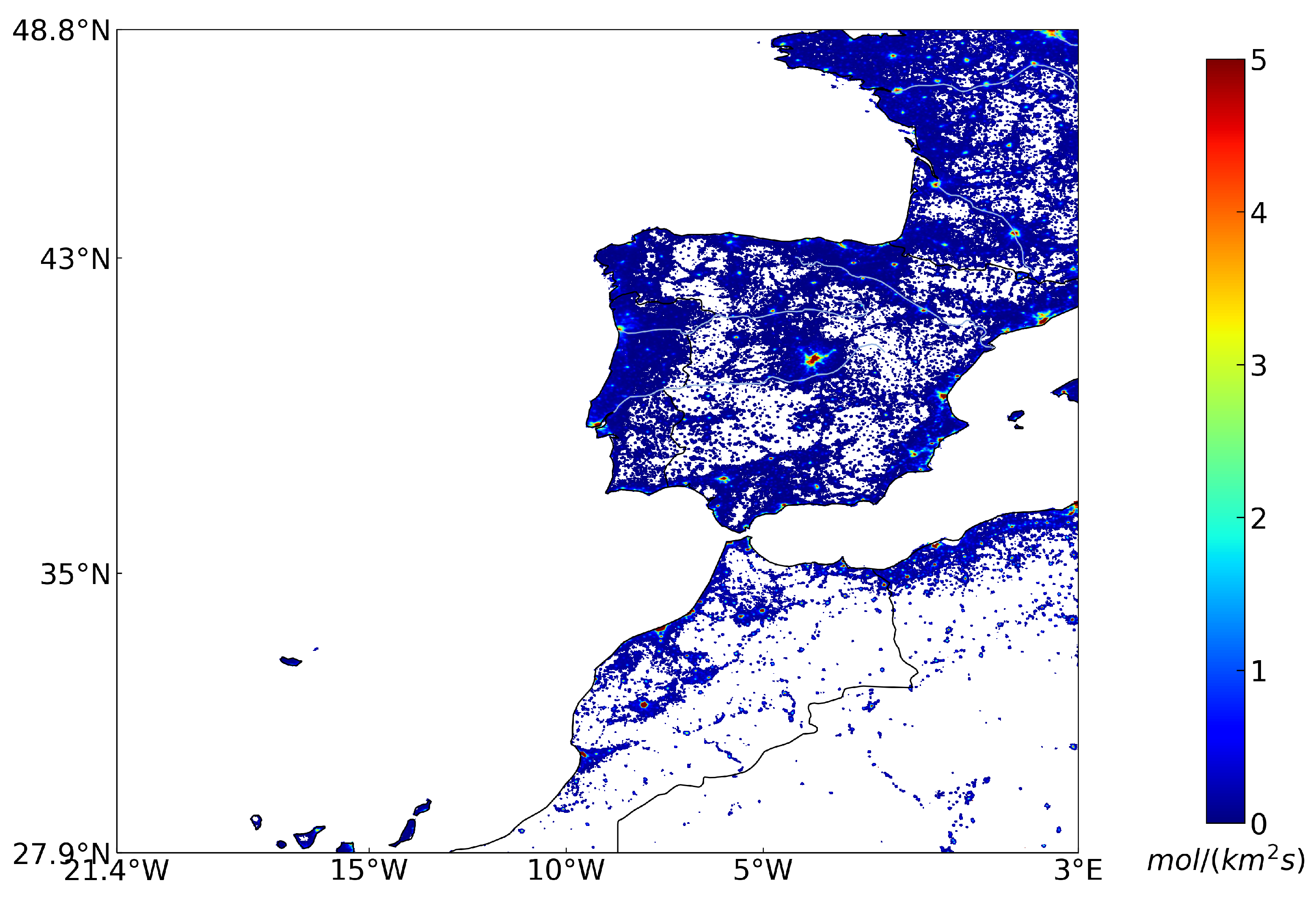
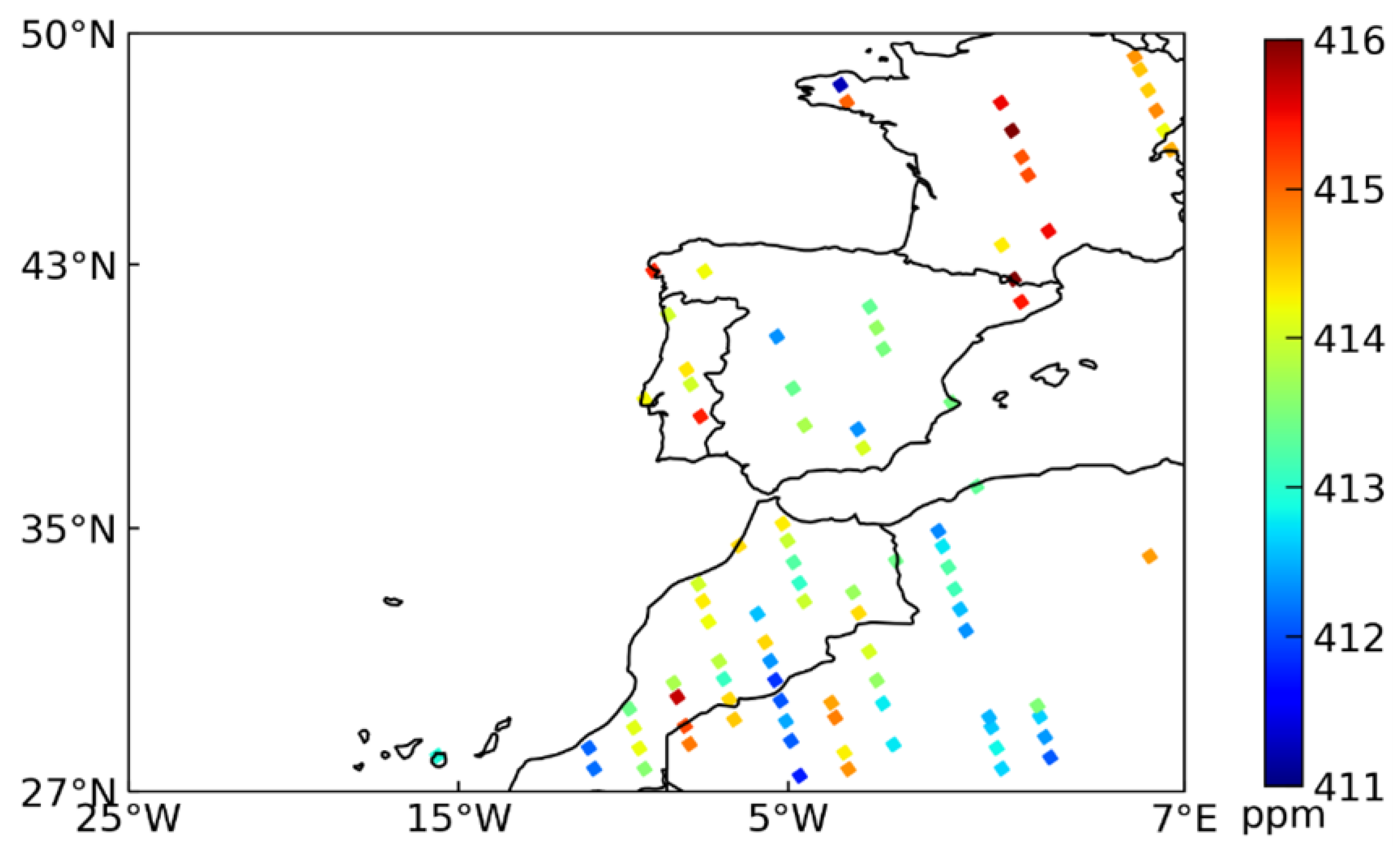
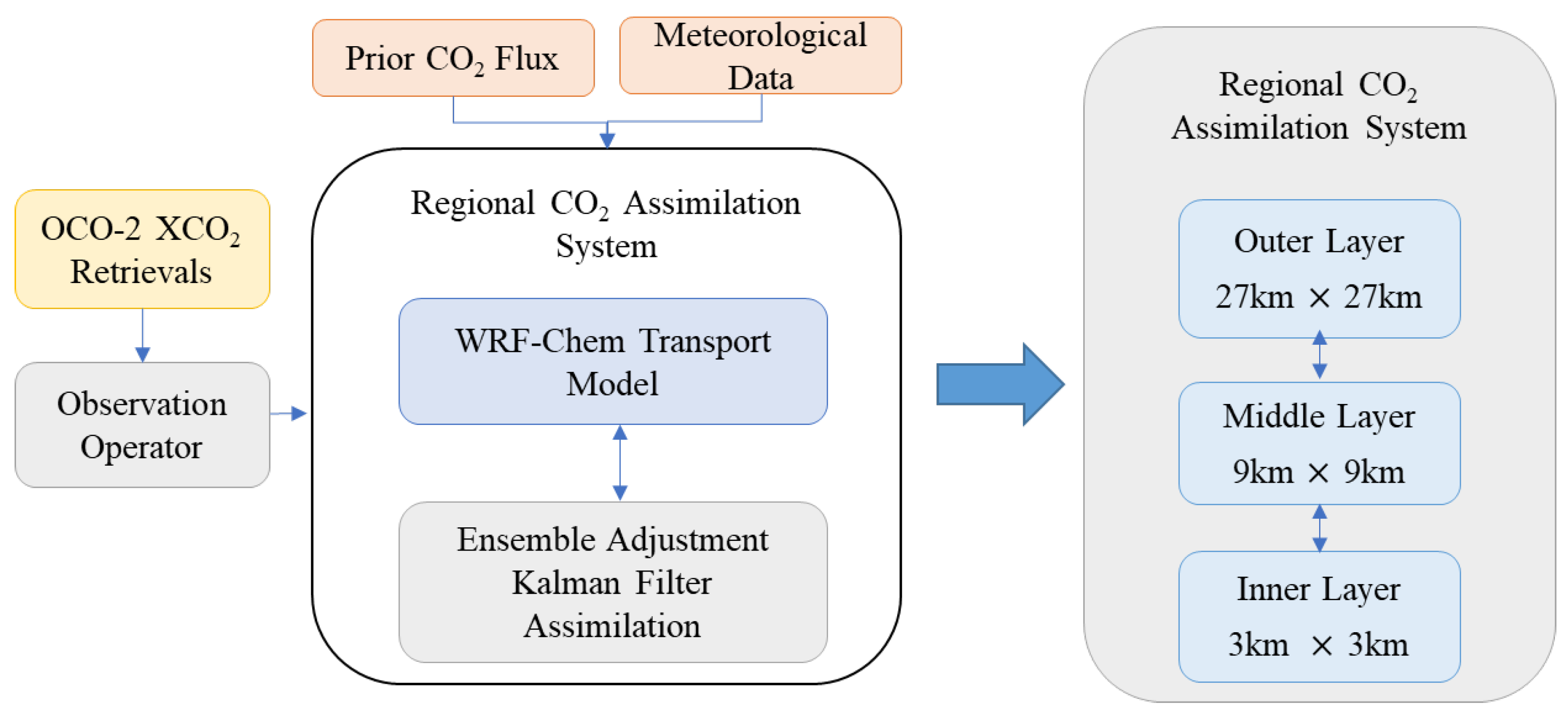
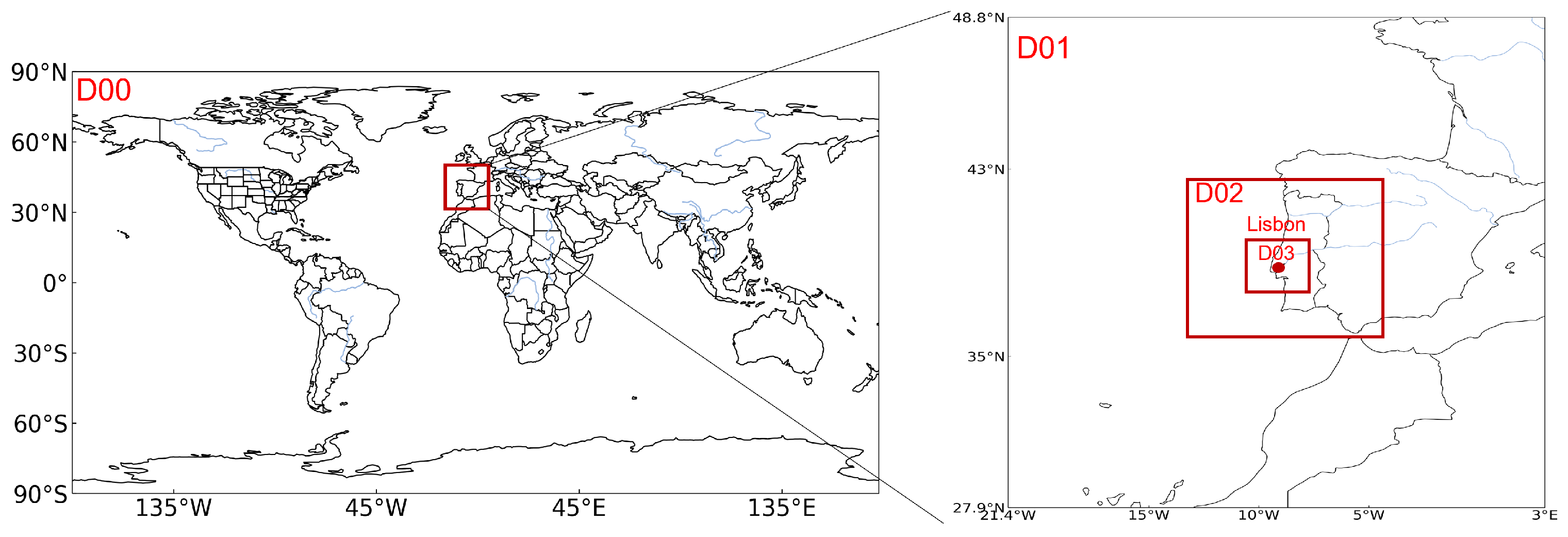
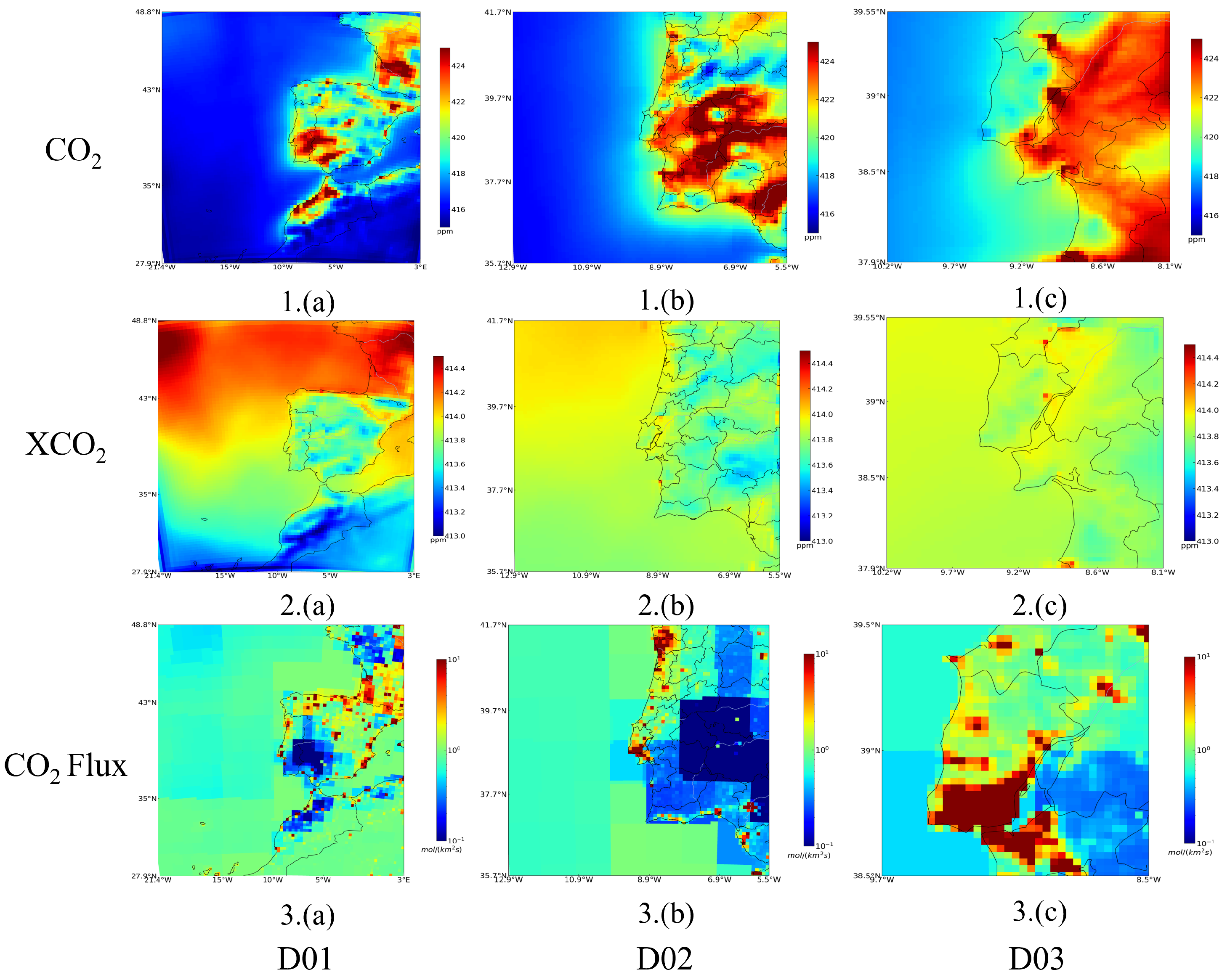

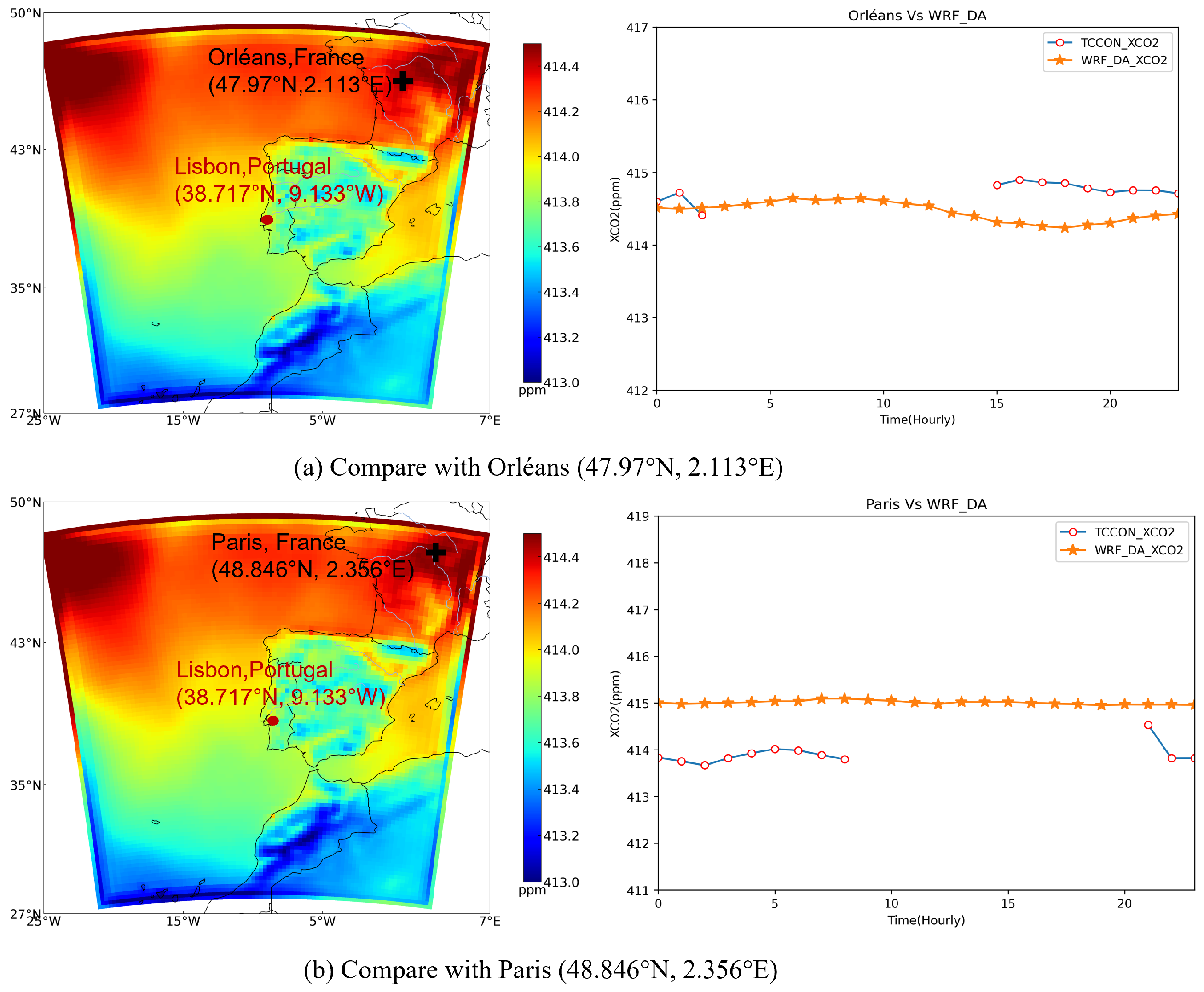
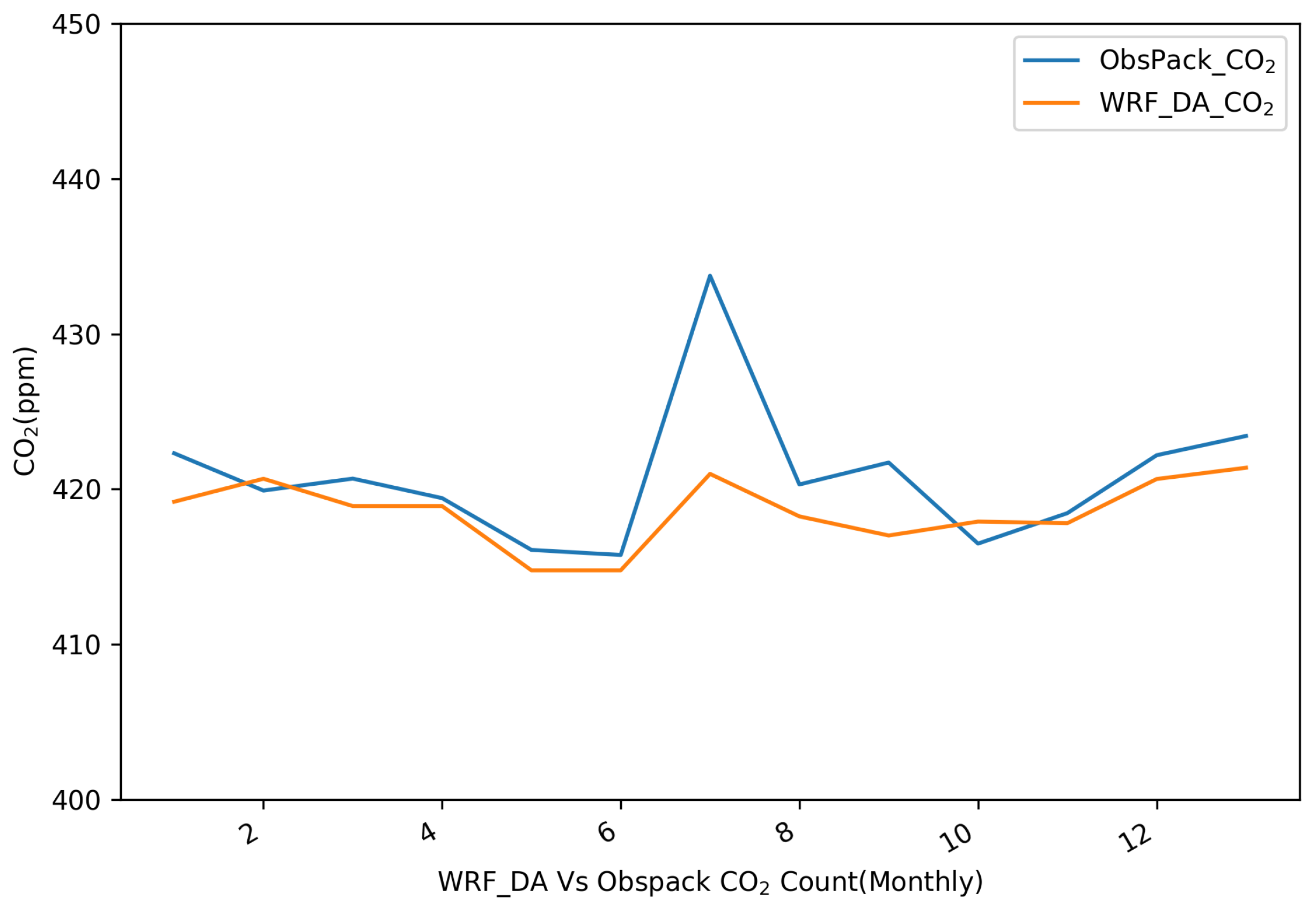

| Options | Configurations |
|---|---|
| WRF_Core | ARW |
| Domain center | 38.717° N, −9.133° W |
| Max_dom | 3 |
| Grid resolution | 27 km, 9 km, 3 km |
| Vertical level( nz) | 48 |
| Nx_CR, Nx_FR, Nx_IR | 90, 76, 64 |
| Ny_CR, Ny_FR, Ny_IR | 90, 76, 64 |
| Interval seconds | 21,600 s/6 h |
| Time steps | 90 s |
| Start date | 1 March 2020 00:00:00 |
| End date | 31 March 2020 18:00:00 |
| Microphysics process | WSM 5-class simple ice scheme [43] |
| Cumulus parameterization | Kain–Fritsch scheme [44] |
| Longwave atmospheric radiation | RRTM scheme [45] |
| Shortwave atmospheric radiation | Dudhia scheme [46] |
| Planetary boundary layer scheme | MYNN 2.5 level TKE [47] |
| Surface layer scheme | MYNN [48] |
| Land surface scheme | Unified Noah Land surface model |
| Chemistry option | chem_opt = 16 (CO2 only) |
| Vs. Orléans | Vs. Paris | |||
|---|---|---|---|---|
| TCCON | DA Experiment | TCCON | DA Experiment | |
| Numer | 1639 | 733 | 2313 | 733 |
| Mean XCO2 | 414.78 ppm | 414.47 ppm | 413.85 ppm | 415.01 ppm |
| 0.31 ppm | 1.16 ppm | |||
| ObsPack | DA Experiment | |
|---|---|---|
| Numer | 13 | 13 |
| Mean CO2 | 420.81 ppm | 418.55 ppm |
| 2.26 ppm | ||
| MBE | 2.25 ppm | |
| MAE | 2.59 ppm | |
| RMSE | 4.06 ppm | |
| CORR | 0.68 | |
Disclaimer/Publisher’s Note: The statements, opinions and data contained in all publications are solely those of the individual author(s) and contributor(s) and not of MDPI and/or the editor(s). MDPI and/or the editor(s) disclaim responsibility for any injury to people or property resulting from any ideas, methods, instructions or products referred to in the content. |
© 2025 by the authors. Licensee MDPI, Basel, Switzerland. This article is an open access article distributed under the terms and conditions of the Creative Commons Attribution (CC BY) license (https://creativecommons.org/licenses/by/4.0/).
Share and Cite
Jin, J.; Huang, Y.; Wei, C.; Wang, X.; Xu, X.; Gu, Q.; Wang, M. Analysis of CO2 Concentration and Fluxes of Lisbon Portugal Using Regional CO2 Assimilation Method Based on WRF-Chem. Atmosphere 2025, 16, 847. https://doi.org/10.3390/atmos16070847
Jin J, Huang Y, Wei C, Wang X, Xu X, Gu Q, Wang M. Analysis of CO2 Concentration and Fluxes of Lisbon Portugal Using Regional CO2 Assimilation Method Based on WRF-Chem. Atmosphere. 2025; 16(7):847. https://doi.org/10.3390/atmos16070847
Chicago/Turabian StyleJin, Jiuping, Yongjian Huang, Chong Wei, Xinping Wang, Xiaojun Xu, Qianrong Gu, and Mingquan Wang. 2025. "Analysis of CO2 Concentration and Fluxes of Lisbon Portugal Using Regional CO2 Assimilation Method Based on WRF-Chem" Atmosphere 16, no. 7: 847. https://doi.org/10.3390/atmos16070847
APA StyleJin, J., Huang, Y., Wei, C., Wang, X., Xu, X., Gu, Q., & Wang, M. (2025). Analysis of CO2 Concentration and Fluxes of Lisbon Portugal Using Regional CO2 Assimilation Method Based on WRF-Chem. Atmosphere, 16(7), 847. https://doi.org/10.3390/atmos16070847







